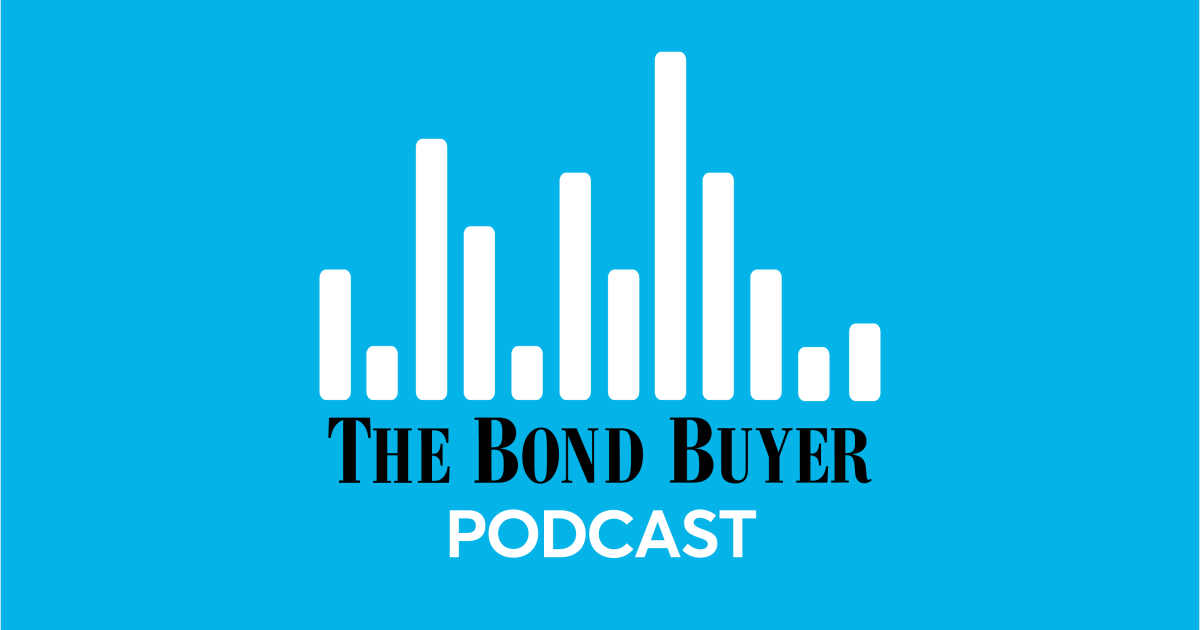Mass transportation post-pandemic: Coping with the end of federal aid
13 min read

Transcription:
Thomas Nocera (00:03):
Welcome to another episode of the Bond Buyer podcast. I’m Thomas Nocera, regional reporter for the Bond Buyer, and I’m joined by Bill Glasgall, senior Director of Public Finances at the Volcker Alliance. You recently led a special briefing with co-host Jeannie Birch from the University of Pennsylvania on the future of mass transportation as the US pandemic nears an end. Mass transit ridership in the US is still down a third or more since COVID and Federal Pandemic Aid that helped prop up operations is set to dry up. It’s bringing about a new thinking towards revenue streams as well as the general structures of mass public transit across the nation. Now, the part I wanted to start on; it was mentioned in that special briefing that mass transit was at an inflection point. Can you explain what that means?
William Glasgall (00:45):
Oh, sure Thomas. Mass transit is really, it’s more than an inflection point. That’s the polite way to put it. Most systems are at a potential crisis point. Federal COVID funding is running out. Most transit systems around the country have structural budget deficits that were there before COVID and will be there after COVID. And with one possible exception in Atlanta, there are fiscal cliffs coming in the next couple of years.
Thomas Nocera (01:19):
Now, when this federal funding does dry up for most mass transportation operators, what are they going to face and what are riders going to face?
William Glasgall (01:29):
Well, let’s start with the good. The MTA Metropolitan Transportation Authority in New York, that’s the biggest mass transit system in the country. They’ve got their operating budget pretty well balanced until 2028, and that’s because the state is providing a bunch of new dedicated funding. There already are a variety of tax revenues that go to the M T A and the state threw in some emergency aid plus downstate casino revenue, a wage surtax in New York City. So they’re kind of all set until some of that state aid emergency aid runs out in 2028. Less fortunate are systems like the DC Metro in the Washington area, SEPTA in Philly, all of the transit systems in California, they’re existing. They’re really existing on emergency state aid to tie them over, but they don’t have long-term dedicated sources of funding, and that’s the big problem.
Thomas Nocera (02:35):
And in terms of finding these new long-term dedicated sources of funding, it’s made a little bit more complicated by possibly some of the demographics. I know S&P believes that now we’re at a third of what it used to be and it might be the new level that we’re looking at for mass transit use in the U.S. What creative ways maybe are people coming up with to address that?
William Glasgall (03:04):
Well, if you’re a system like New Jersey Transit, it relies on farebox revenue for more than 60% of system revenue. That’s a real problem because farebox revenue is not coming back. You can raise fares. They are in New York City and the MTA. You can raise fares, but then there’s the risk that it will just divert more people to their cars. We don’t know. It’s a bit of a quandary. So the idea of a long-term dedicated revenue source is very important. Some systems have sales taxes that are devoted to mass transit. New Jersey effectively has a long-term solution because it’s been diverting money from the New Jersey Turnpike and the Clean Energy Fund for years and years. Again, it’s effectively permanent, it could change in a tough year with a budget. So that’s the real solution. These public goods, like roads, airports, they all have dedicated funding sources. Most road systems rely on gasoline taxes or diesel taxes or vehicle miles traveled or tolls mass transit people don’t like as much.
Thomas Nocera (04:30):
When we’re looking at solutions for mass transit systems in terms of meeting this potential fiscal cliff, can you apply the same ideas, the same logic, the same funding solutions to systems that are gigantic, maybe like New York’s, like California’s, as opposed to other systems that are struggling that might be smaller? Or is there a different type of logic you have to approach it with?
William Glasgall (04:52):
Well, I think that transit systems that really exist to funnel people in and out of central cities like the DC Metro, the MBTA in Boston, the MTA, they have have some unique situations because they really depend on a vibrant downtown and a vibrant work from office or work from your store or from your factory culture. California is perhaps a little different. The BART system is very much an old style system, bringing people in from around the San Francisco Bay area into San Francisco that has a host of problems, probably the worst work from home numbers in the country or close to it. So there are differences, but even though a lot of California’s mass transit systems are much more spread out, the legislature just came up with over $5 billion in emergency aid, which will work for a few years. They recognize that there’s a public need here.
Thomas Nocera (06:04):
Now in January, I believe S&P changed the US transportation sectors viewed to negative, and it cited a lack of improvement on finding a solution for that. What took so long to get around this. When did the transit agencies and leaders start thinking about this?
William Glasgall (06:38):
Well, they’ve been thinking about it since before COVID. This situation is a long time coming. Remember, a lot of mass transit systems are cobbled together out of bankrupt remnants of once upon a time for-profit systems. The entire mass transit system from Boston to Washington is built on top of the ruins of the Pennsylvania Railroad and the New York Central, the Penn Central, other railroads. So people have been thinking about this for years. They were certainly thinking about it when everything shut down and some of the transit systems decided to keep maximum service going because otherwise essential workers weren’t going to get to their places of work. So yes, they’ve been thinking about it, but Congress came through with tons of aid, mostly operating aid. They provided a loan to the M A $2 billion loan, and that made the crisis go away for the moment. But this has been on people’s minds constantly.
(07:57)
I can’t speak for the rating agencies, but they’re looking at the here and now, the transit agencies we’re getting federal aid, everything was being put together. Then they start looking at the future, and that’s where they changed their outlook because they’re realizing that the money is running low. I don’t think any transit system is near default bonds. The bonds are usually covered by some form of revenue and transit defaults are, I can’t think of one except maybe the Las Vegas monorail. It was really a private enterprise that was in the muni market. So they’re not going to go broke overnight, but they have long-term structural problems, and that’s either going to mean less service, higher fares, labor concessions or dedicated revenue from states and counties or some combination.
Thomas Nocera (09:07):
We’ll be right back after this important message, and we’re back talking with Bill Glasgow, senior Director of Public finances at the Volcker Alliance. So in rethinking mass transit operations and funds from a bottom up way, participants at the special briefing mentioned different novel ways to either change mass transit or generate revenue. Some of them were fixed routes, the use of algorithms to identify rider centers and other basic changes. And one of those changes was linking local and regional mass transit networks. And this is something I’ve heard before covering this topic, and I was wondering what exactly that is, if you could speak to it and how it might end up saving or how it might steady the transportation system for the future.
William Glasgall (09:58):
Well, one of the problems that a lot of transit systems have is getting people to the bus or to the train or to the trolley. So the question is, can para transit or rideshares e-bikes, scooters – what mode of transportation is going to get people from here to there? You won’t have a one seat ride all the way to work, but that’s not the big problem if you want to get into town. How do we encourage people to get to the central point? So it’s making sure that if you’re talking about buses, making sure that the bus schedules are coordinated with the train schedules. It’s not always that easy because this might involve multiple unions, multiple work rules, multiple authorities, a regional or local bus authority and a regional or local train authority. Very often transit systems are fragmented, especially unions, work rules, track gauges, types of equipment.
(11:13)
So getting those on a single page is probably very useful. Another thing that they’re trying in Philadelphia right now is selling blocks of transit tickets to big employers who can add a big, big discount who can then give these out as free employee benefits. So there’s a lot of talk about free mass transit, let’s get rid of the fares, and we’re going to be in Nirvana where it’s not clear where the money’s going to come from for that, but what SEPTA is betting on is that they’ll generate more volume at the margin. People will like free transit, big employers, big employers want to keep their employees happy, and I think they have four or five big employers already lined up for that. So that’s important.
Thomas Nocera (12:11):
That’s interesting. There also seems to be some host hopes of cost saving by leveraging new technologies. And in particular, I’m thinking about green technologies with all the money that’s been pumped into green energy transitions and transportation transitions. People are retrofitting their bus fleets, things like this. Can that green infrastructure funding that’s working its way to transportation agencies potentially be a game changer or really a benefit to these transportation agencies moving forward, possibly facing reduced ridership, things like that?
William Glasgall (12:50):
Oh, probably there’s a lot of funding in the transportation bill, in the infrastructure bill, also in the inflation reduction act for green transportation and transit systems around the country are really counting on capital money for new rolling stock that doesn’t fix their operating problem. So you can get a new train, a new bus, a new locomotive to pull your trains, but you’ve still got to pay the people to run the trains and run the stations and all that. How many people will there be on these new trains? It’s possible to do a robotic, an unperson robotic train. Probably at some point you’ll have robotic buses, but not right now. The unions in the MTA are really resisting. One operator trains, one operator trains for the subways. The MTA could save a ton of money, but the flip side of that is will people feel less safe? We don’t know. It’s an open question, but there’s a lot of new equipment coming for sure.
Thomas Nocera (14:21):
And in your opinion, I don’t know if you’ll be able to speak to this on a larger scale possibly from New Jersey, but in terms of the politics that’s influencing and driving some of these decisions, do you think that wise decisions are being made? Are they taking into account demographic changes, expectations for drops in ridership possibly, or is it still a little bit difficult on some state levels to get people on board with this?
William Glasgall (14:50):
Oh, it’s very difficult. There are a lot of places where people just don’t like mass transit and cities, metropolitan areas have grown up around the car. Los Angeles once had a vibrant streetcar system, and the auto industry made very sure that that cruised off into the sunset. Boston and Philly still have pieces of a streetcar system that hold the networks together. But people, when you work, work in a city and you live out in the suburbs and your job is not in downtown, your job is 40, 50 miles away around the circle, if you can’t get there by mass transit and it’s not particularly cost effective to run a bus or a train line all day long around that circle, then how do you get there? We’re a car-centric nation. It’s a big problem for the environment and it’s a big problem for downtowns, but this is what we have. So when Jeanie Birch spoke on our program, she asked, why do people hate mass transit? She’s right. A lot of people do.
Thomas Nocera (16:11):
So looking at these funding streams and new revenue streams are seeking, these are long-term solutions and long-term to long-term problems. I wonder what success would look like maybe in a general sense in the next five months, six months in terms of writing this fiscal bolt for different transit operators.
William Glasgall (16:30):
Maybe it’s longer than five or six months. Almost all the states have concluded their budgets. Newsflash, just as we’re taping this program, the Massachusetts legislature kind of made a deal to give the governor the fiscal 24 budget, which includes about half a billion dollars for transportation in which is based on a millionaire surtax. Massachusetts went from being a progressive tax state to a flat tax state and then back to a progressive tax state, and they’re like New York. They’re using some of that money for transportation. So this is really a longer term solution. New Jersey has asked about for a solution for NJ Transit for as long as I can remember. Volcker Alliance has consistently dinged New Jersey in its budget practices for diverting capital funds to operating funds for diverting turnpike and clean energy revenues to mass transit. There’s a social good in this, but it’s an annual decision also. Legislatures don’t like to be pinned down.
(17:58)
I’m a senator, I’m a representative right now. I vote for a program, I want to be darn sure that that’s not going to hurt me in the long term. And that’s an issue. They may not want to be committed to a tenure or a 20 year solution like you have in Atlanta or New York where you’ve really got a dedicated revenue source and mass transit in Atlanta is an uphill struggle. Getting people to ride MARTA has always been an issue, and it’s not the biggest system in the world. And there are suburbs that don’t want mass transit because they don’t want people coming out from the city to move to their towns that they just take me off the grid.
Thomas Nocera (18:43):
This is gloomy and there’s issues obviously that are being faced. I’m wondering, looking into the future, what a positive things, maybe a strength of transit operators in the US or the industry as a whole has going forward. Is there anything inherent natural to what they’re doing that suits well for the future?
William Glasgall (19:08):
Well, I think there’s a realization in a lot of metropolitan areas that if you want to bring the cities back, if you want to get people either commuting back, commuting into the city or reap repurposing some of those offices for residences or laboratories, there’s a lot of biotech conversion going on or data centers. You do need a transportation strategy to be part of this. You can’t just plunk a bunch of people down in the middle of a city in what used to be office buildings said, oh, here’s your apartments now. How are we going to get around? If you don’t have a transportation solution, then you are only partway there. So that’s one thing to really consider, and maybe that’s a bright outlook. The other thing is that, and this may be good news for the bond market as well as for transportation systems, the infrastructure bill I mentioned before, has a lot of money in it for new capital improvements.
(20:22)
If New York City gets congestion pricing underway, that’s a billion dollars a year in new revenue, which the MTA plans to bond out right away. So there’s going to be, there’s a lot of new capital revenue coming in, which will probably support some fairly robust bond issuance. And that’s good because you can’t run a train or bus system on 40 year old equipment. So we’re seeing a lot of support for that and better equipment. Who wants to ride a 60 year old train to work that’s kind of rattly and bouncy and that doomed the MTA once upon a time. It was dooming NJ transit at one point. You got to stay modern. The DC Metro has had derailments accidents, fires. Old equipment is not how you get people back onto the system.
Thomas Nocera (21:33):
Bill Glasgall of the Volcker Alliance, thank you very much for being here with us today. And thank you to the listeners of this Bond Buyer podcast. Special thanks to Kevin Parise who did the audio production for this episode, and don’t forget to rate us, review us and subscribe at www.bondbuyer.com/subscribe. For the Bond Buyer, I’m Thomas Nocera and thanks for listening.







